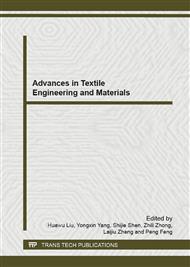p.233
p.239
p.243
p.248
p.252
p.258
p.263
p.267
p.271
The Brief Study on the Inscription-Brocade and Weaving Technology of the Han Dynasty
Abstract:
Inscription-brocade played an important role in the history of textile technology and exerted great influence upon social production of the Han Dynasty in China. Through analyzing the features of the inscription on the brocade and the social reasons for their emergence, we believe there is a close relationship among the inscription and the social custom, psychology and artistic style of the time. In addition, the perfect combination of inscription and patterns on the brocade stood witness to the mighty advance in the silk technology, the weaving machine such as multi-heald and multi-pedal loom, and the technical application for weaving warp-faced patterns.
Info:
Periodical:
Pages:
252-257
Citation:
Online since:
December 2012
Authors:
Price:
Сopyright:
© 2013 Trans Tech Publications Ltd. All Rights Reserved
Share:
Citation:


